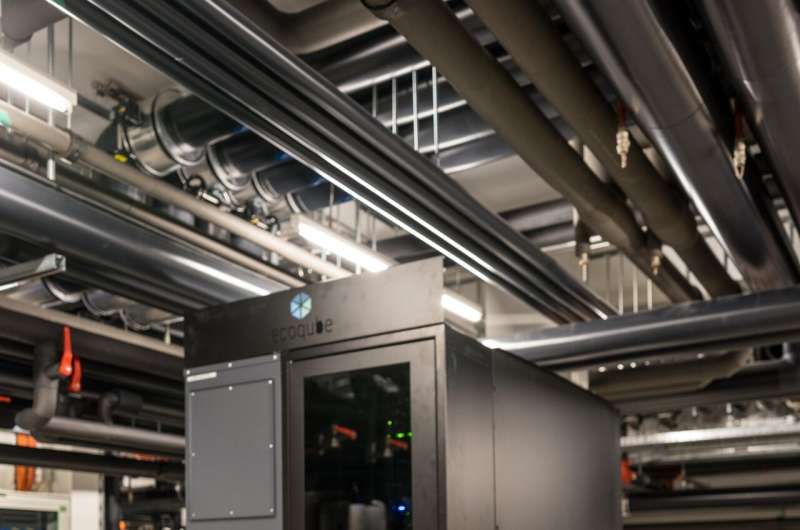
A click on the internet leaves traces behind. Not only in the web itself, but also in the form of a large ecological footprint. Because even though all our data is supposedly floating in the cloud, physical data centers are required to process and store it, and these consume huge amounts of energy—a significant proportion of which is used to cool the facilities due to the enormous amount of waste heat that is generated during computation. The big tech giants are now well aware of their responsibilities, investing generously in renewable energy and looking for ways to optimize the energy efficiency of their server farms. One of these paths, for example, leads to the Arctic Circle, where some of the largest data centers are currently located. The cold temperatures there help to reduce the amount of energy needed to cool the equipment.
With the latest digital trends such as artificial intelligence (AI), augmented reality (AR) and the Internet of Things (IoT), however, further challenges lie ahead: The volumes of data to be processed are increasing rapidly, and at the same time, reactions are required in real time—without delay. To achieve this, the processing of the data must move closer to the place where it was created. For instance, in the form of a micro data center in the neighborhood. In the best case, however, this local data center will not only be used for data processing, but—connected to the energy system—will also be used to heat the building. A field test with micro data centers in the NEST research building at Empa and at two other locations in Turkey and Netherlands aims to explore the potential of this idea.
Intelligent cooling
The project, called ECO-Qube, is supported by the EU’s Horizon 2020 program and brings together research and industry partners from Switzerland, Turkey, Spain, Germany, Netherlands and Sweden. “Our goal is to reduce both the energy demand and CO2 emissions of small data centers by one-fifth each,” says Çağatay Yılmaz, Innovation Manager at Turkish IT solution provider Lande and ECO-Qube project leader. According to the Sustainable Digital Infrastructure Alliance, another project partner, conventional data centers often operate at only about 15 percent of their capacity. Despite this, the servers constantly need power and are cooled. To counter this problem, the cooling of the ECO-Qube data centers is made intelligent: Sensor data from the individual IT components are accumulated into Big Data structures and help to ensure that the heat distribution within the components is accurately recorded at all times. AI combines this data with airflow simulations so that cooling can be specifically targeted. At the same time, the computing loads in the three test data centers in Switzerland, Turkey and the Netherlands are distributed in such a way that all three facilities can be operated as energy-efficiently as possible.
Reusing waste heat
The three data centers will be integrated directly into the energy systems of their surrounding neighborhoods and are to be supplied with renewable energy whenever possible. In NEST, for example, the electricity for operating the data center is provided by the photovoltaic systems of the NEST units and Empa’s mobility demonstrator, move, among others. The waste heat from the data center is fed into the existing medium- or low-temperature network. In winter, it thus directly feeds the building’s heating system and, over the year, simultaneously serves as a source for a heat pump that provides domestic hot water.
“For us, it is interesting to consider the micro data center not just as an electrical consumer, but as a dynamic component in the overall system that we can use so that calculations take place when it makes sense ecologically. The coupling of the electrical and thermal world with the IT infrastructure and data processing offers great potential for optimization towards sustainable operation,” says Philipp Heer, Head of the Energy Hub (ehub) at Empa.
The project will last about three years. After completion, the team hopes to be able to provide guidelines for planners and building operators to help them integrate data centers into buildings and neighborhoods in an energy-efficient manner.
Cooler data centers help take the heat off electric bills
Citation:
How data processing can heat buildings (2022, March 1)
retrieved 1 March 2022
from https://techxplore.com/news/2022-03-how-data-processing-can-heat.html
This document is subject to copyright. Apart from any fair dealing for the purpose of private study or research, no
part may be reproduced without the written permission. The content is provided for information purposes only.
Stay connected with us on social media platform for instant update click here to join our Twitter, & Facebook
We are now on Telegram. Click here to join our channel (@TechiUpdate) and stay updated with the latest Technology headlines.
For all the latest Technology News Click Here
For the latest news and updates, follow us on Google News.
